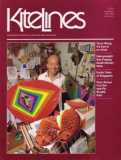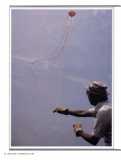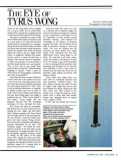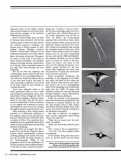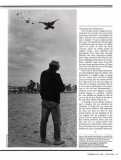Cover: Tyrus Wong smiles in his studio at Sunland, California, where he is surrounded by kites, materials and mementos of his life as a designer with Disney Studios. In his hands is an elliptical kite in rainbow colors, in the foreground a pair of fish line climbers, in the background one of his angel kites along with centipedes and parts of centipedes.
North of the smog lanes of Los Angeles lies a canyon where the air seems fresh. Nestled there among the eucalyptus trees is the home and kite studio of Tyrus Wong.
The spot is animated by some of the most brilliant kites made in America — and by a wiry artist of 73 years who bounces around with the enthusiasm of a teenager. Wong has been involved in kites for about six years, since he made a large multicolor banner for kiteflier Dick Ames (of Flying Tiger kite reels) to use as a signal at the beach. A neighbor’s bamboo was handy and he used it to make his first kite, a swallow — the Chinese omen of happiness. It didn’t fly properly so Tyrus rebuilt it and then made another one — and another. “Up to five! All on one string! Then before I knew it I had 25 ! ” Tyrus exclaims, laughing at himself. “Then I made 25 white doves for flying against a solid blue sky. Then 25 butterflies.”
Tyrus flies his kites on about 1000 feet of line — and here is the essence of his art — with all the kites branching off the main line. Thus the kites are uniform structures but their flying patterns are “free” — free to fly in different directions, to interplay in lifelike motion and even to dash to earth — where Tyrus simply picks them up and sets them flying again. Are tangles a problem? Oh yes. “Then I pour myself a stiff drink,” Tyrus laughs. But the pleasures derived from the branching technique, for him, outweigh the risks.
Next Tyrus was taken by centipedes. Bill Everett had one and Tyrus had to try making his own. Again, the first effort didn’t balance properly and Tyrus found that the right choice of line was essential. He also devised a three-line holder that gives him more precise flying control. Now he has five centipedes, including two precious miniatures. As he says, “I’m centipede happy.” He builds his centipedes in sections of 10 with clips to ease the separation of tangled portions. One of 'his centipedes appeared (without credit to Wong) on the jacket of the book Better Kite Flying for Boys and Girls, published in 1980. Someone said that the centipede photograph provided a sole but sufficient reason for a serious kiter to place the book in his or her library.
[…]
